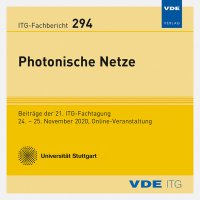Influence of dispersive element on phase noise suppression in Talbot effect based optical upconversion scheme
Conference: Photonische Netze - 21. ITG-Fachtagung
11/24/2020 - 11/25/2020 at online
Proceedings: Photonische Netze
Pages: 5Language: englishTyp: PDF
Authors:
Neumann, Niels; Al-Husseini, Zaid; Plettemeier, Dirk (Chair for RF and Photonics, Engineering, TU Dresden, Dresden, Germany)
Abstract:
The temporal Talbot effect supports the generation of RF signals with high purity in optical domain. This allows for example a remote RF generation without the need for costly highend electronic circuits and resource sharing. However, one of the most interesting features of the approach is its inherent ability to suppress phase noise during the carrier generation process. Besides the comb laser source, the dispersive element is the key component in this upconversion scheme. Ideally, it provides the right amount of dispersion over the whole spectral range of the comb. Broader combs are expected to allow a higher degree of phase noise suppression. The simulation of phase noise of an RF tone generated by an optical scheme is challenging in terms of computational and memory effort. Therefore, a simulation tool taking advantage of the properties of the comb and the Talbot effect had to be developed. In this paper, the dependency of the phase noise suppression on the dispersion characteristic is investigated yielding an important input to the design of these elements. First, the implemented simulation tool and the simulation parameters ensuring a correct estimation of the phase noise before and after dispersion influence are introduced. Then, the effect of different dispersion characteristics on the phase noise behavior is analyzed. It could be shown and explained how the phase noise at different offset frequencies to the carrier is affected differently depending on the dispersion characteristic and also the comb width. Design rules for the required comb width as well as the acceptable variation of the produced dispersion from the ideal value depending on the demands for the phase noise improvements could be developed and will be presented.


